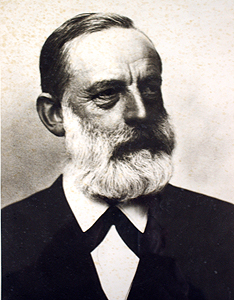|

|
| |
|
 |
|
Lothar Meyer |
|
*19.8.1830 †11.4.1895
in Tübingen 1877-1895 |
| |
|
| |
|
| |
|
| |
|
| |
|
| |
|
|
|
|
back to History
|
|
|
|
|
 Julius
Lothar Meyer (August 19, 1830 - April 11, 1895) was born in Varel,
at that time belonging to the duchy of Oldenburg, now part of
Germany. He was contemporary and competitor of Dmitri Mendeleev to
draw up the first periodic table of chemical elements. Some five
years apart, both Mendeleev and Meyer worked with Robert Bunsen.
Meyer qualified in medicine at Zürich, Switzerland, and then
studied and taught at various German universities. His first
interest was the physiology of respiration, and in 1857, he
recognized that oxygen combines with the haemoglobin in blood. In
1864, Meyer published an early version of the periodic table,
containing 28 elements classified into 6 families by their
valence-the first time that elements had been grouped and ordered
according to their valence. Work on organizing the elements by
atomic weight had hitherto been stymied by inaccurate measurements
of the atomic weights. Mendeleev published his periodic table of
all known elements (and predicted several new elements to complete
the table, plus some corrected atomic weights) in 1869. Working
completely independently, a few months later, Meyer published a
revised and expanded version of his 1864 table, virtually
identical to that published by Mendeleev, and a paper showing
graphically the periodicity of the elements as a function of
atomic weight. Many chemists were doubtful about Mendeleev's
periodic law, but Meyer's work provided significant support,
particularly when the new elements were found as predicted and
remeasured atomic weights accorded with those predicted. Meyer's
contributions also included the concept that the carbon atoms in
benzene were arranged in a ring, although he did not propose the
alternation of single and double bonds that later became included
in the structure by Kekulé. Julius
Lothar Meyer (August 19, 1830 - April 11, 1895) was born in Varel,
at that time belonging to the duchy of Oldenburg, now part of
Germany. He was contemporary and competitor of Dmitri Mendeleev to
draw up the first periodic table of chemical elements. Some five
years apart, both Mendeleev and Meyer worked with Robert Bunsen.
Meyer qualified in medicine at Zürich, Switzerland, and then
studied and taught at various German universities. His first
interest was the physiology of respiration, and in 1857, he
recognized that oxygen combines with the haemoglobin in blood. In
1864, Meyer published an early version of the periodic table,
containing 28 elements classified into 6 families by their
valence-the first time that elements had been grouped and ordered
according to their valence. Work on organizing the elements by
atomic weight had hitherto been stymied by inaccurate measurements
of the atomic weights. Mendeleev published his periodic table of
all known elements (and predicted several new elements to complete
the table, plus some corrected atomic weights) in 1869. Working
completely independently, a few months later, Meyer published a
revised and expanded version of his 1864 table, virtually
identical to that published by Mendeleev, and a paper showing
graphically the periodicity of the elements as a function of
atomic weight. Many chemists were doubtful about Mendeleev's
periodic law, but Meyer's work provided significant support,
particularly when the new elements were found as predicted and
remeasured atomic weights accorded with those predicted. Meyer's
contributions also included the concept that the carbon atoms in
benzene were arranged in a ring, although he did not propose the
alternation of single and double bonds that later became included
in the structure by Kekulé.
|
|
|
|
![]()